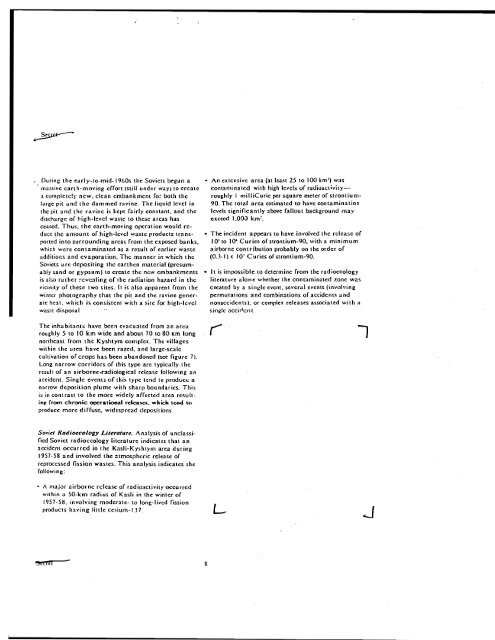Chernobyl Nuclear Power Plant CIA Files - Paperless Archives
Chernobyl Nuclear Power Plant CIA Files - Paperless Archives
Chernobyl Nuclear Power Plant CIA Files - Paperless Archives
Create successful ePaper yourself
Turn your PDF publications into a flip-book with our unique Google optimized e-Paper software.
• Durine the early-to-mid-1960s the Soviets began a<br />
ma5~ive earth-moving effor! (still under way; to create<br />
a completely new. clean embankment fo~ both the<br />
large pit and the dammed ravine. The liquid level in<br />
the pit and the ravine is kept fairly constant. and the<br />
discharge of high-level waste to these areas has<br />
ceased. Thus. the earth-moving operation would reduce<br />
the amount of high-level waste products transported<br />
into surroundin!! areas from the exposed banks.<br />
which were contaminated as a result of earlier waste<br />
additior.s and evaporation. The manner in which the<br />
Soviets arc depositing the earthen material (presumably<br />
sand or gypsum) to create the new embankments<br />
is al50 rather :-evcaling oCthe radiation hazard in the<br />
vicinity of these two sites. It is also apparent from the<br />
winter photography that the pit and the ra"ine generate<br />
heat. which is consistent with a s;te for high-level<br />
waste disposal<br />
The inhabitants have been evacuated from an area<br />
roughly 5 to 10 km wide and about 70 to 80 ICm long<br />
northeast from the Kyshtym compicx. The villages<br />
within the area have been razed. and large-scale<br />
cultivation of crop:; has been abandoned (sec figure 71.<br />
Long narrow corridors of this type are typically the<br />
result of an airborne,radiological rclease following an<br />
accident. Single events of this type tend to produce a<br />
narrow deposition plume with sharp boundaries. This<br />
is in contrast to the more widely affected area resulti"1!<br />
froon ehronic (lpCf"atioftai reka~. whicl! tend to<br />
produce more diffuse. widespread depositions<br />
• An extensive area (atlcast 25 to 100 km'l was<br />
contaminated with high levels of radioactivityroughly<br />
I milliCurie per square meter of strontium-<br />
90. The total area estimated to have contamination<br />
levels significantly above fallout background may<br />
exceed 1.00\) km'.<br />
• The incident appears to have involved the re\ca!;e of<br />
10' to 10' Curies of strontium-90. with a minimum<br />
airborne contribution probably on the order of<br />
(0 . .1-11 x 10' Curies of strontium-90.<br />
• It is impossible to determine from the radioecology<br />
literature alone whether the contaminated 1.one was<br />
cllCatcd by a sinj(1e event. several events (involving<br />
permulations and combinations of accidents and<br />
nonaccidentsl. or complex releases associated with a<br />
single acciclent<br />
l<br />
So_i~1 Radioecology Literature. Analysis of unclassified<br />
Soviet radioecology literature indicates that an<br />
accident occurred in the Kasli-Kyshtym area during<br />
1957-58 and involved the ::tmospheric release of<br />
reprocessed fission wastes. This analysis indicates the<br />
following:<br />
• A majar airborne release of radioactivity occurred<br />
within a 50-km radius of Kasli in the winter of<br />
1957-5!!. involving moderate- to long-lived fission<br />
products having little cesium-13 7.<br />
L<br />
~tftl<br />
8
















